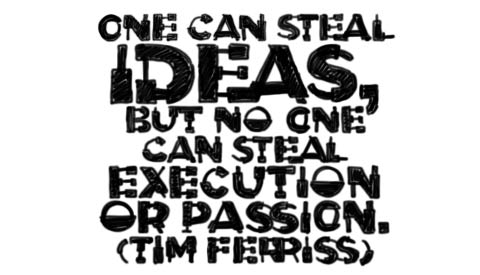Success Advice
3 Powerful Life Lessons From the Multi Millionaire “Tim Ferriss”

Tim Ferriss (if you’re not familiar with his work) is a New York Times and Wall Street Journal best selling author, an angel investor in companies such as Facebook, Twitter, Uber, and Evernote, a blogging/podcasting extraordinaire with more than 1 million monthly visitors to his site, and the first American to hold a Guinness World Record in tango.
He’s one of the only people in the world whose other accomplishments completely dwarf the fact that he’s a Princeton alumnus.
But aside from his laundry list of achievements, Tim is also the world’s leading authority on Lifestyle Design.
What exactly is that? An entirely new and rapidly growing category of blogs, businesses and books focused on challenging traditional assumptions and living a richer life.
In his debut novel, The 4-Hour Workweek, Ferriss begs the question: Why should you have to wait until you’ve worked 40+ years and you’re 65 years-old to start traveling, spending quality time with friends and family, and taking up new hobbies?
Why not live the life you want right now? Why not enjoy every waking moment to the fullest?
Ferris firmly believes in turning the traditional American retirement plan upside down. And rather than deferring all your happiness to the future (65+ years old), he presents the case for us to streamline our lives, build our own business, find joy, travel the world and be passionate today.
As we gear up for the New Year with resolutions and goal setting on our mind, it may be time to revisit a few of the powerful life lessons embedded in his timeless classic, The 4-Hour Workweek.
By applying Ferriss’s philosophies to our next-year’s goals, we’re certain to kick start the year off right and catapult ourselves to greater levels of success.
So let’s dive right in and begin designing the lives we want, TODAY, using these potent principles.
1. 80/20 your way to success
Otherwise known as Pareto’s Law, the 80/20 rule says that 80 percent of the results for any given activity come from just 20 percent of the inputs. This is the foundation for many of Ferriss’ guiding tenants. One example of the rule in action for entrepreneurs is 80 percent of your business’s revenue typically comes from just 20 percent of your client/customer base.
Ferriss argues that you should eliminate the 80 percent of things you’re doing that aren’t yielding significant results. And instead you should focus exclusively on the 20 percent of activities that are. In doing so, you free up A TON of your time to focus on duplicating those actions/clients/processes that yield high returns. The 80/20 rule works in the opposite way as well.
Normally, you’ll see that 80 percent of your problems in business or in life come from just 20 percent of the people and clients you interact with.
Remove the 20 percent, and the majority of your problems disappear. Especially as we gear up for the New Year and new goals this principle can be very powerful in terms of showing us the best areas to focus on for maximum results.
However, 80/20 isn’t set in stone; it’s simply a starting point for your analysis. Sometimes you’ll find the ratio to be even higher at 90/10 or even 99/1. Whatever the case, you can channel your energy and stop wasting time on fruitless goals with this in your arsenal.

2. Never underestimate the impact of time and mobility on your happiness
A lot people (especially us entrepreneurial types) like to think that money alone will make us happier. Even if we intellectually know that money by itself doesn’t lead to happiness, we still have a tendency—year after year—to make higher income one of our top goals.
This can be very powerful and beneficial, IF done the right way. But for most of us, we just arbitrarily pick an income goal that’s higher than the last year. Instead, we should be picking an income or revenue goal that allows to do the things we want with our lives.
What does that mean? Here’s an example: Let’s say we run an online merchandising business that typically profits $100,000 per year. At that level, let’s say the owner spends 30 hours per week on the business and has time to take three, 2-week vacations throughout the year. The business stays running and automated just fine. However, what most people would do in this situation is raise the goal above $100,000 in profit to $200,000 in profit. Now, instead of 30 hours per week, let’s say the owner spends 80 hours per week on the business (more time acquiring new clients, dealing with customers, and processing orders) and has ZERO time for a vacation.
Which life would you prefer? If we truly look at it, the person making $200K is poorer in terms of time and mobility than the person making $100K. Now am I saying you shouldn’t be ambitious and raise your goals? Absolutely not! But what you MUST always do is consider WHY you want the goals your setting. If your income is going to provide a certain lifestyle for you, but achieving that level of income doesn’t allow you ANY free time, should you really have that goal? We must always remember that being in control of our own time and destiny is essential to long-term happiness, and understanding this is crucial for setting your next year’s goals.

3. Always push yourself outside your comfort zone.
Throughout the 4-Hour Workweek, Ferriss lists Comfort Challenges at the end of nearly every chapter.
These challenges range from walking up and getting a guy or girl’s phone number to testing your skills in negotiation at flea markets.
Why did Tim choose to scatter these throughout his book? He summarizes the answer in this quote:
“Success can be measured by the number of uncomfortable conversations you’re willing to have.”
Essentially, he’s saying get outside your comfort zone and keep pushing yourself. That’s how 26 out of 27 publishers turned down Ferriss’ idea before he finally got his book published—he kept pushing past doubt and his comfort zone. And when his book launched, it became an instant best seller.
Ferriss’ message for entrepreneurs is you have to get outside your comfort zones and develop socially so you can effectively present and sell your ideas and concepts. But more importantly, the key to a rich life is connecting with people and forging lasting friendships. To do that you have to know how to talk to anyone, with confidence and be persuasive. If your 2015 goals don’t include an element of that, you should revisit and refine them until they do.
Crush it in 2015! And if you haven’t already pick up a copy of The 4-Hour Workweek or any other of Tim Ferriss’ masterpieces.
A Day In The Life of Tim Ferriss
Success Advice
Wealth Lessons Everyone Should Hear for Every Stage of Your Life
Do you have the courage to rewrite your story?

Do you see what I see? Likely not, as we each see ourselves through the lens of our own story. (more…)
Success Advice
How to Choose the Best Affiliate Programs for Your Blog
If you follow these steps, you can create an affiliate marketing plan that makes money, fits well with your content, and connects with your readers

Picking the right affiliate programs for your blog is really important. It can make a big difference in how much money you can make and how much your readers get out of your blog. With so many choices out there, deciding which ones to go with can be tricky.
This guide is here to make it easier for you. It will give you clear steps and helpful tips to choose affiliate programs that fit well with what your blog is about, what your readers like, and what you stand for.
For more articles on this theme, please head over to this blog https://blog.partners1xbet.com/.
Understanding Affiliate Marketing
Before you start picking affiliate programs, it’s important to really understand what affiliate marketing is and how it works.
Basically, affiliate marketing is when you promote a product or service on your blog, and then you get paid a little bit every time someone buys something or does something because you recommended it.
It’s great for both the person selling the product and the blogger, because the seller gets more sales with low risk, and the blogger can make money from their blog.
How to Choose the Right Affiliate Programs for Your Blog
1. Assess Your Niche and Audience
The key to doing well in affiliate marketing starts with really knowing what your blog is about and who reads it. Consider the following:
- Your blog’s content: What topics do you cover? Ensure the products or services you promote are relevant.
- Your audience’s interests and needs: What solutions are they seeking? Choose affiliate programs that offer products or services that solve their problems or enhance their lives.
2. Research Potential Affiliate Programs
Once you know what your blog is about and what your readers want, start looking for affiliate programs. Choose ones that are well-known for good products, great customer service, and helpful support for affiliates. Resources to find these programs include:
- Affiliate networks like ShareASale, Commission Junction, and ClickBank.
- Direct searches for “[Your Niche] affiliate programs” in search engines.
- Recommendations from other bloggers in your niche.
3. Evaluate the Commission Structure
The commission structure is a critical factor to consider. Look for programs that offer competitive rates that make your efforts worthwhile. Consider:
- The percentage of commission per sale.
- Whether the program offers a flat rate per action (e.g., per sign-up).
- The cookie duration, which affects how long after a click you can earn commissions on sales.
4. Consider the Program’s Reputation and Sureness
Join affiliate programs with a solid reputation for quality and sureness. This not only ensures that you’re promoting good products but also that you’ll be paid on time. You can:
- Read reviews from other affiliates.
- Check the program’s history and background.
- Look for any complaints or issues reported online.
5. Analyze the Support and Resources Offered
A good affiliate program gives you things like ads to use, training on their products, and helpful managers. Having access to these resources can really help you do a better job at promoting their products.
6. Understand the Terms and Conditions
Before signing up, thoroughly review the program’s terms and conditions. Pay close attention to:
- Payment thresholds and methods.
- Any restrictions on how you can promote their products.
- The program’s policy on affiliate marketing on social media platforms.
7. Test the Product or Service
If possible, test the product or service before promoting it. This firsthand experience allows you to offer genuine charge and build trust with your audience.
8. Look for Recurring Commission Opportunities
Some affiliate programs pay you again and again for subscriptions or services that charge fees regularly. These can provide a more stable income compared to one-time sales commissions.
Implementing Your Choice
After choosing the best affiliate programs, the next step is to smoothly include your affiliate marketing in your content plan. This includes:
- Creating valuable content that naturally incorporates affiliate links.
- Disclosing your affiliate affairs transparently to maintain trust with your audience.
- Tracking your results to understand what works best for your audience and adjusting your strategy accordingly.
Picking the best affiliate programs for your blog involves careful planning, research, and making sure they match what your audience likes and needs.
If you follow these steps, you can create an affiliate marketing plan that makes money, fits well with your content, and connects with your readers.
The real key to doing well with affiliate marketing isn’t just about the products you talk about, but also how much your audience trusts and values your advice.
With enough time, patience, and hard work, your blog can grow into a successful space that earns a good amount of affiliate money and helps your readers choose the right products.
Success Advice
The Power of Ethical Leadership: How Integrity Drives Success
By leading with integrity and ethics, leaders create an environment where employees feel excited to come to work

What differentiates a positive organizational culture that enjoys a clean reputation and long-term success from a toxic culture drowning in scandals, mistrust, and legal fines? (more…)
Success Advice
10 Landing Page Hacks Experts Are Using to Generate Leads
Crafting a landing page that converts is both an art and a science

If you are in the online marketing world, you know the importance of a high-quality landing page. It’s like a secret sauce that can turn a casual user into a solid lead. I will walk you through ten great tips that have worked wonders for me and could do the same for you in creating landing pages that generate leads. (more…)
-

 Life4 weeks ago
Life4 weeks agoThe Best Techniques to Boosting Your Memory in a Busy World
-

 Success Advice4 weeks ago
Success Advice4 weeks agoAn Easy to Follow 8 Step Strategy for Creative Problem Solving
-

 Entrepreneurs4 weeks ago
Entrepreneurs4 weeks agoCrisis-Proof Your Business Now: Essential Strategies for Every Entrepreneur
-

 Success Advice3 weeks ago
Success Advice3 weeks ago10 Landing Page Hacks Experts Are Using to Generate Leads
-

 Entrepreneurs3 weeks ago
Entrepreneurs3 weeks agoThe Mindset Shifts Required to Become a Successful Online Entrepreneur
-

 Success Advice2 weeks ago
Success Advice2 weeks agoThe Power of Ethical Leadership: How Integrity Drives Success
-

 Entrepreneurs2 weeks ago
Entrepreneurs2 weeks ago6 Hacks to Boost Your Productivity as a Business Owner
-

 Success Advice1 week ago
Success Advice1 week agoHow to Choose the Best Affiliate Programs for Your Blog































4 Comments